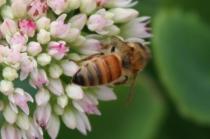
UNIVERSITY PARK – Penn State’s efforts to address Colony Collapse Disorder (CCD), a nationwide phenomenon in which the adult honeybees of a hive disappear, often spelling death for the colony, will benefit from a gift of $100,000 to aid pollinator research.
Honey distributor Dutch Gold Honey and William and Kitty Gamber, of Lancaster, Pa., have each contributed $50,000 to endow a fund that will support undergraduates in the College of Agricultural Sciences. First preference for the Dutch Gold Honey and William R. Gamber II Endowment in Entomology will be given to juniors and seniors involved in honeybee research.
“Finding solutions to the challenges facing honeybees and other pollinators will take a sustained effort over many years,” said Bruce McPheron, dean of the College of Agricultural Sciences. “The foresight and generosity of Dutch Gold and the Gamber family embodied in this endowment will help us train the next generation of scientists who will take the lead in future research to ensure the health of pollinators and their habitat.”
William Gamber’s parents, Ralph and Luella Gamber, founded Dutch Gold Honey in the kitchen of their Lancaster home in 1946, with an investment of $27 and three hives. William and his sisters, Nancy and Marianne, became a part of the family business at a young age and eventually took over operations upon their parents’ retirements.
William Gamber was named president of Dutch Gold Honey in 1992 and retired in 2002, but continues as chairman. Nancy Gamber Olcott is the company’s current president and CEO, and Marianne Gamber serves as secretary/treasurer. Today, Dutch Gold Honey is the largest family-owned honey company in the U.S., annually shipping more than 50 million pounds of product worldwide.
Previous philanthropy to Penn State from Dutch Gold Honey has included a 2002 gift to name the Dutch Gold Honey Research Laboratory in the Food Science Building on the University Park campus.
In the last four years Colony Collapse Disorder has affected honeybee colonies all across the nation, with losses ranging from 30 percent to near 100 percent in apiaries with CCD symptoms. The disorder is still not fully understood. Researchers at Penn State’s Center for Pollinator Research have been investigating why CCD happens and developing ways to strengthen the pollinator population.
The center, comprising 26 independent research, extension and outreach groups across the University, is sponsoring the first International Conference on Pollinator Biology, Health and Policy, to be held July 24-28, with the goal of bringing together researchers, policymakers, and conservationists to address this complex issue. The focus of the conference will be current research on the factors influencing pollinator decline, as well as policies and practices in relation to pollinator conservation.
For more information on the Center for Pollinator Research, visit online.
Laura Stocker Waldhier, Penn State University


